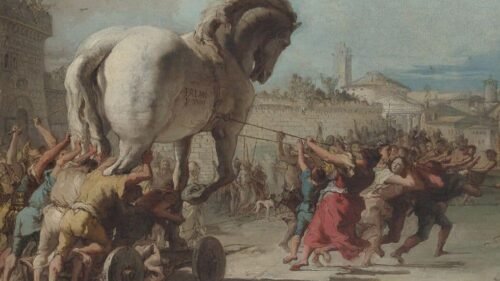On July 23, 2025, the world of theater dimmed as Ratan Thiyam, the visionary playwright, director and cultural luminary, took his final bow at the age of 77 in Imphal’s Regional Institute of Medical Sciences (RIMS) Hospital. His passing marks the end of an era — not just for Indian theater, but for the global stage — where his work transcended borders, languages and cultures to speak to the universal human spirit.
To call him a theater artist or director is to undersell the magnitude of his genius. He was a Theater Scientist — a master alchemist who fused the ancient with the contemporary, the local with the universal and the spiritual with the political. His stage was a laboratory where Manipuri traditions, global aesthetics and the raw pulse of human experience were distilled into works of unparalleled beauty and truth.
A life dedicated to the stage
Born on January 20, 1948, in Imphal, Manipur, Ratan Thiyam was a polymath whose creative journey began in painting and writing before finding its ultimate expression in theater. A graduate of the National School of Drama (NSD) in 1974, he founded the Chorus Repertory Theater in 1976 on the outskirts of Imphal, creating a sanctuary where Manipur’s syncretic culture could engage in dialogue with the world.
His theater productions were not mere plays but profound meditations on war, identity and humanity’s eternal quest for meaning. Ratan Thiyam’s Mahabharata trilogy — Urubhangam (1981), Chakravyuha (1984) and Karnabharam (1989) — along with works like Uttar Priyadarshi and Lairembigee Eshei, offered piercing philosophical commentaries on human conflict and moral dilemmas.
The trilogy, rooted in Bhasa’s Sanskrit classics and Thiyam’s own Chakravyuha, symbolically portrayed an individual’s struggle against structural violence and their inevitable surrender to it. Urubhangam depicted Duryodhana’s shattered body and spirit, Chakravyuha captured Abhimanyu’s tragic entrapment through visceral choreography and Karnabharam explored Karna’s existential crisis amid cosmic conflict.
As critic Samik Bandyopadhyay, quoted by Dr. Pinak Sankar Bhattacharya, observed:
Beginning with Bhasa’s Urubhangam in 1981, following it up in 1984 with his own Chakravyuha and culminating with Bhasa’s Karnabharam in 1989, Ratan completed a Mahabharata trilogy, linked thematically by the central presence of an individual facing an onslaught of violence, a kind of cosmic, global flow of violence that compels him to question his identity.
Thiyam’s 2014 Macbeth, reimagined in a Meitei context with Manipuri music and the Manipuri martial art of Thang-Ta, transformed Shakespeare’s tragedy into a universal yet deeply local exploration of ambition and ruin.
In India, Thiyam’s theater stood alone — blending Manipuri traditions with modern sensibilities in ways unmatched by other Indian playwrights like Badal Sircar’s urban realism or Habib Tanvir’s folk experiments. His work formed a bridge between the ancient Natya Shastra, Thang-Ta and global theatrical forms like Japanese Noh and Greek tragedy.
Globally, his ritualistic intensity drew parallels with Polish theater director Jerzy Grotowski’s spiritual minimalism, English film and theater director Peter Brook’s intercultural scope and Japanese theater director and theorist Tadashi Suzuki’s physical precision. Yet his work remained uniquely rooted in Manipur’s syncretic heritage.
His productions stunned global audiences with their surreal universality. Thiyam’s stage was a crucible where Manipuri aesthetics met the world’s theatrical traditions, cementing his legacy as a visionary without equal.
Theater as cultural resistance
Thiyam’s theater was also a rebellion against the colonial hangover that sought to erase India’s indigenous roots. As a leading figure in the Theater of Roots movement, alongside luminaries like Indian filmmaker B.V. Karanth and Indian dramatist Kavalam Narayana Panikkar, he reclaimed Manipuri traditions — its dances, music and storytelling — and wove them into narratives that challenged power structures and societal norms.
His adaptation of Jean Anouilh’s Antigone, titled Lengshonnei, critiqued political failures in Manipur, while his Macbeth exposed the timeless nature of human ambition and moral collapse. His plays were mirrors to Manipur’s turbulent socio-political landscape, reflecting the pain of ethnic strife, insurgencies and the scars of war.
As he once said, “War affects children. War affects women; it makes prostitutes out of them. All this is not normal.” His was a war on war — fought with the weapons of art, empathy and relentless creativity.
Global parallels: A theater without borders
Thiyam’s work was a rich tapestry of global influences — yet always firmly grounded in Manipur’s soil. Like Grotowski, Thiyam stripped theater to its emotional and spiritual core, using disciplined choreography and haunting choral music to evoke primal truths.
Like Brook, he drew from diverse traditions to craft a theatrical language that resonated across continents, from Oslo’s National Theater’s Ibsen Festival to Seoul’s Theater Olympiad. His When We Dead Awaken (2010), a Manipuri interpretation of Ibsen, astonished Norwegian audiences with its surreal aesthetics and spiritual intensity.
Thiyam’s ability to blend the local and the universal paralleled the work of Suzuki, whose Suzuki Method of Actor Training emphasized physicality and cultural memory — similar to Thiyam’s use of Thang-Ta and Meitei rituals.
His visually spectacular productions, described as “lyrical and surreal,” echoed the grandeur of Ariane Mnouchkine’s Théâtre du Soleil, where myth and history collide in vibrant spectacle. Yet Thiyam remained uniquely himself — a son of Manipur who carried its stories, struggles and syncretic beauty to the world stage.
Voices of admiration
Thiyam’s impact was deeply felt in the words of those who witnessed his work. Former Manipur Chief Minister N. Biren Singh mourned his passing: “His unwavering dedication to his craft, his vision, and his love for Manipuri culture enriched not only the world of theater but also our very identity.” Theater scholar Samik Bandyopadhyay described Thiyam as “a poet of the stage,” capable of infusing plays with “rationalized and multifaceted analysis of myriad perspectives.” Actor Rohini Hattangadi, Thiyam’s NSD classmate, recalled him as “studious, curious and always experimenting with sounds and movements.”
Internationally, The Oxford Companion to Theatre and Performance hailed him as “India’s most internationally recognized director,” known for “visually spectacular productions that reflect the state of global culture.” On social media, users called him a “doyen of Manipuri theater” and a “visionary icon” who “brought modernity to performance.”
His final play, Lairembigee Eshei, performed in Delhi on February 17, 2025, was described as a haunting reflection on ecological apocalypse — a fitting culmination of his lifelong concern for humanity’s future.
A roaring legacy
When Thiyam was alive and roaring, the media rightly celebrated him as a revolutionary. The Hindu (2018) described him as a “celebrated theater director and poet” whose work grappled with the “dark times” of modernity — from digital isolation to global violence.
The Indian Express (2020) praised his role in the Theater of Roots movement, noting how his plays challenged colonial stereotypes and reasserted Indian identity through Manipuri aesthetics. India Today (2018) quoted Thiyam’s belief, “Diverse art practices teach us how to be human and show our place in this universe” — a philosophy evident in his productions at the 8th Theater Olympics.
His awards — Sangeet Natak Akademi Award (1987), Padma Shri (1989), Kalidas Samman (1997), Sangeet Natak Akademi Fellowship (2012) and Manipur’s Lifetime Achievement Award (2025) — were only modest affirmations of a legacy that defies quantification.
Preserving the legacy of a Theater Scientist
Ratan Thiyam’s departure leaves a void, but his legacy must not fade. His Chorus Repertory Theater, a cultural beacon in Imphal, must be preserved and supported as a living archive of his work, training future generations in his interdisciplinary methods. As Thiyam advocated at the Ningtham Khumhei Shumang Leela Festival in January 2025, a world-class cultural complex in Manipur is essential to safeguard the state’s artistic heritage.
His scripts, recordings and production notes should be digitized and made accessible globally, ensuring that works like Chakravyuha and Uttar Priyadarshi continue to inspire. Institutions like NSD, where Thiyam served as director (1987–88) and chairperson (2013–17), must integrate his methodology into curricula, emphasizing the fusion of traditional and contemporary forms.
Festivals like Bharat Rang Mahotsav, which championed his works, should dedicate retrospectives to him, showcasing his ability to speak to both local and global audiences. Moreover, his call for unity through culture must guide the healing of Manipur’s ethnic wounds.
A final curtain call
Ratan Thiyam was not just a theater maker. He was a philosopher, a rebel, a dreamer who saw the stage as a force for social change and spiritual awakening. His theater was a sacred space where Manipur’s stories — its pain, its beauty, its resilience — echoed across continents. As he once lamented, “The digital age has made sure the past does not matter,” yet his work stands as a defiant testament to the enduring power of cultural memory.
To lose Thiyam is to lose a guiding star — but his light will shine on in every artist he inspired, every audience he moved and every stage that dares to dream as boldly as he did.
Rest in peace, Oja Padma Shri Ratan Thiyam. Your theater was a revolution, your science a revelation and your legacy an eternal flame. As one X user poignantly wrote: “Heroes get remembered, but legends never die. He will be in our hearts forever.”
[Corporate Tycoons first published a version of this piece.]
[Kaitlyn Diana edited this piece.]
The views expressed in this article are the author’s own and do not necessarily reflect Fair Observer’s editorial policy.
Support Fair Observer
We rely on your support for our independence, diversity and quality.
For more than 10 years, Fair Observer has been free, fair and independent. No billionaire owns us, no advertisers control us. We are a reader-supported nonprofit. Unlike many other publications, we keep our content free for readers regardless of where they live or whether they can afford to pay. We have no paywalls and no ads.
In the post-truth era of fake news, echo chambers and filter bubbles, we publish a plurality of perspectives from around the world. Anyone can publish with us, but everyone goes through a rigorous editorial process. So, you get fact-checked, well-reasoned content instead of noise.
We publish 3,000+ voices from 90+ countries. We also conduct education and training programs
on subjects ranging from digital media and journalism to writing and critical thinking. This
doesn’t come cheap. Servers, editors, trainers and web developers cost
money.
Please consider supporting us on a regular basis as a recurring donor or a
sustaining member.
Will you support FO’s journalism?
We rely on your support for our independence, diversity and quality.









Comment